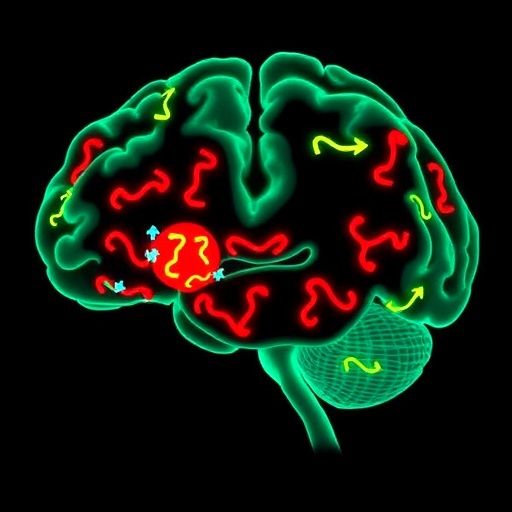Neurodegenerative diseases are a significant concern in modern medicine, impacting millions of individuals globally. Prominent disorders such as Alzheimer’s disease, Parkinson’s disease, frontotemporal lobar degeneration, and multiple system atrophy are centrally characterized by the accumulation of pathological proteins in the brain. The intricate tapestry of neurodegenerative diseases reveals how specific proteins form complex aggregates that lead to detrimental effects on neuronal function. In particular, five key proteins have emerged as critical players in the pathology of these disorders: amyloid-β (Aβ), tau, α-synuclein, TAR DNA-binding protein 43 (TDP43), and fused in sarcoma (FUS). Each of these proteins has been linked to distinct disease mechanisms, while their interactions also raise fascinating questions about the fundamentals of neurodegeneration.
Among these proteins, amyloid-β has been extensively studied due to its central role in Alzheimer’s disease. The aggregation of Aβ into fibrillar structures is associated with neurotoxic effects that lead to synaptic dysfunction and ultimately neuronal death. The significance of imaging technologies, particularly positron emission tomography (PET), has revolutionized our understanding of Aβ deposition. This imaging modality now allows researchers and clinicians to visualize Aβ accumulation throughout the progression of Alzheimer’s disease. With ongoing advancements in PET technology, it is increasingly feasible to monitor responses to therapies aimed at targeting amyloid-β, although challenges remain regarding the detection of specific Aβ assembly subspecies.
In addition to Aβ, tau protein has garnered attention for its critical involvement in various neurodegenerative disorders. The formation of tau tangles, another hallmark of Alzheimer’s disease, is a central focus of current research. Various PET radiotracers have been developed to detect tau deposits, enabling researchers to distinguish between Alzheimer-type tau pathology and non-Alzheimer-associated tau aggregates. A deeper understanding of the binding mechanisms of these radiotracers, as revealed by high-resolution imaging techniques like cryo-electron microscopy, is shedding new light on the structural nuances of tau fibrils and enhancing the specificity of tau imaging.
Moreover, α-synuclein has been at the forefront of research into Parkinson’s disease and multiple system atrophy. The development of high-contrast PET imaging techniques for visualizing α-synuclein lesions has marked a notable advancement in neuroimaging. This progress holds promise for diagnosing these conditions at earlier stages, thereby improving patient management and treatment outcomes. Despite these advancements, there remains a wealth of α-synuclein pathologies that are less prevalent and more challenging to visualize. Continued exploration in this area is essential to broaden our understanding of the diverse manifestations of synucleinopathies.
TDP43 and FUS represent additional proteins whose misfolding and aggregation are associated with neurodegenerative diseases. The detection of these protein aggregates through imaging techniques poses unique challenges due to their lower prevalence compared to amyloid-β and tau. However, innovative public–private partnerships focused on biomarker development may provide the momentum needed to address these hurdles. By fostering collaborations among academic institutions, pharmaceutical companies, and biotech firms, there is immense potential to accelerate the discovery of reliable imaging agents for TDP43 and FUS.
As the landscape of neurodegenerative disease research evolves, the integration of advanced imaging techniques into clinical practice is becoming increasingly valuable. PET imaging helps to not only visualize the presence of pathological protein aggregates but also to assess their dynamic changes over time in response to therapeutic interventions. This capability transforms the traditional methods of diagnosing neurodegenerative diseases, providing a window into the underlying biological processes.
The significance of this research extends beyond diagnostic applications. Understanding the dynamics of protein aggregates through advanced imaging can pave the way for developing targeted therapies. As we better understand the mechanisms by which specific proteins contribute to neurotoxicity, we can identify appropriate therapeutic targets and tailor treatments for individual patients based on their unique pathological profiles.
Moreover, the advances in imaging technologies are allowing for a more comprehensive view of neurodegenerative disease progression. These insights can potentially lead to the development of novel drug candidates that interfere with the aggregation processes of these critical proteins. For example, targeting the interactions between amyloid-β and tau may yield therapeutic strategies that can influence disease outcomes positively.
Overall, the strides made in PET imaging are opening new avenues for research and clinical interventions. With ongoing investigations into neurodegenerative diseases, the promise of personalized medicine becomes increasingly achievable. The potential of these imaging technologies to provide real-time assessments of therapeutic efficacy marks a significant step forward in neurodegenerative disease research.
As researchers continue to unravel the complexities of these diseases, the synergy between imaging techniques and molecular biology will undoubtedly drive the field forward. The quest for innovative solutions to combat neurodegenerative diseases is an incredibly interdisciplinary endeavor, requiring collaboration among neuroscientists, pharmacologists, and clinicians.
The future of neurodegenerative disease research is bright, with PET imaging poised to play a pivotal role in shaping our understanding of the underlying mechanisms and guiding the development of novel therapeutic approaches. As we strive to improve diagnostic capabilities and treatment modalities, the importance of these advancements in imaging cannot be overstated. The potential to visualize and characterize neurodegenerative pathologies in vivo will transform how we understand and ultimately address these debilitating diseases.
In summary, the review of advances in PET imaging technologies highlights the significance of visualizing neurodegenerative proteinopathies. The ongoing innovations in this field promise to bring profound changes in diagnosing and treating conditions like Alzheimer’s disease, Parkinson’s disease, and other neurodegenerative disorders, allowing health professionals to offer better care for affected individuals, and providing researchers with new insights into the fundamental mechanisms driving neurodegeneration.
Subject of Research: Advances in PET imaging of neurodegenerative diseases
Article Title: Advances in PET imaging of protein aggregates associated with neurodegenerative disease.
Article References:
Higuchi, M., Tagai, K., Takahata, K. et al. Advances in PET imaging of protein aggregates associated with neurodegenerative disease. Nat Rev Neurol 21, 506–522 (2025). https://doi.org/10.1038/s41582-025-01126-2
Image Credits: AI Generated
DOI:
Keywords: Neurodegenerative diseases, PET imaging, amyloid-β, tau, α-synuclein, TDP43, FUS, protein aggregates, neurotoxicity, diagnostics, therapeutics.
Tags: advancements in imaging technologyamyloid-β in Alzheimer’s diseasebreakthroughs in PET imagingFUS protein and neurodegenerative disordersmonitoring neurodegenerative disease progressionneurodegenerative disease imagingneuronal function and disease mechanismspathological protein aggregationtau protein in neurodegenerationTDP43 in frontotemporal degenerationvisualization of protein deposits in the brainα-synuclein and Parkinson’s disease





